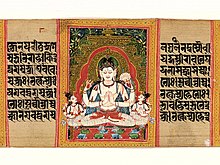


Buddhist texts are religious texts that belong to, or are associated with, Buddhism and its traditions. There is no single textual collection for all of Buddhism. Instead, there are three main Buddhist Canons: the Pāli Canon of the Theravāda tradition, the Chinese Buddhist Canon used in East Asian Buddhist tradition, and the Tibetan Buddhist Canon used in Indo-Tibetan Buddhism.[1]
The earliest Buddhist texts were not committed to writing until some centuries after the death of Gautama Buddha.[2] The oldest surviving Buddhist manuscripts are the Gandhāran Buddhist texts, found in Pakistan and written in Gāndhārī,[3][4] they date from the first century BCE to the third century CE.[5] The first Buddhist texts were initially passed on orally by Buddhist monastics, but were later written down and composed as manuscripts in various Indo-Aryan languages (such as Pāli, Gāndhārī, and Buddhist Hybrid Sanskrit).[1] These texts were collected into various collections and translated into other languages such as Buddhist Chinese (fójiào hànyǔ 佛教漢語) and Classical Tibetan as Buddhism spread outside of India.[1]
Buddhist texts can be categorized in a number of ways. The Western terms "scripture" and "canonical" are applied to Buddhism in inconsistent ways by Western scholars: for example, one authority refers to "scriptures and other canonical texts", while another says that scriptures can be categorized into canonical, commentarial, and pseudo-canonical. Buddhist traditions have generally divided these texts with their own categories and divisions, such as that between buddhavacana "word of the Buddha," many of which are known as "sutras", and other texts, such as "shastras" (treatises) or "Abhidharma".[1][6][7]
These religious texts were written in different languages, methods and writing systems. Memorizing, reciting and copying the texts was seen as spiritually valuable. Even after the development and adoption of printing by Buddhist institutions, Buddhists continued to copy them by hand as a present authenticity exercise and spiritual practice [8]
In an effort to preserve these scriptures, Asian Buddhist institutions were at the forefront of the adoption of Chinese technologies related to bookmaking, including paper, and block printing which were often deployed on a large scale. Because of this, the first surviving example of a printed text is a Buddhist charm, the first full printed book is the Buddhist Diamond Sutra (c. 868) and the first hand colored print is an illustration of Guanyin dated to 947.[9]
- ^ a b c d
• Harvey, Peter (September 23, 2019). "The Buddha and Buddhist sacred texts". www.bl.uk. London: British Library. Archived from the original on November 12, 2020. Retrieved September 23, 2021.
• Barrett, T. H. (September 23, 2019). "Translation and Transmission of Buddhist texts". www.bl.uk. London: British Library. Archived from the original on February 25, 2021. Retrieved September 23, 2021.
• Barrett, T. H. (September 23, 2019). "The Development of the Buddhist Canon". www.bl.uk. London: British Library. Archived from the original on April 7, 2021. Retrieved September 23, 2021. - ^ Lopez, D. S. "Buddha | Biography & Facts". Encyclopædia Britannica. Retrieved November 22, 2021.
- ^ Żmigrodzka, Alicja (February 25, 2023). "2,000–year–old Gandhari Buddhist Manuscripts Find Permanent Home in Pakistan". Khyentse Foundation. Retrieved November 5, 2024.
- ^ "Gandhari Manuscript Project – Gandhāran Buddhist Texts". Retrieved November 5, 2024.
- ^ "Ancient Buddhist Scrolls from Gandhara". UW Press. Archived from the original on May 27, 2017. Retrieved September 4, 2008.
- ^ Macmillan Encyclopedia of Buddhism (Volume One), p. 142
- ^ Bechert & Gombrich, World of Buddhism, Thames & Hudson, London, 1984, p. 79
- ^ Lyons, Martyn, Books: A Living History, J. Paul Getty Museum, 2011, p. 33
- ^ Kieschnick, John (2003) "The Impact of Buddhism on Chinese Material Culture" pp. 177-181. Princeton University Press